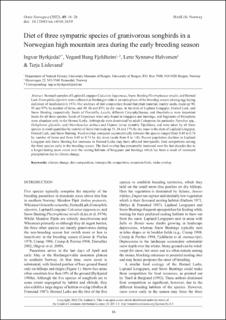| dc.description.abstract | Stomach samples of Lapland Longspur Calcarius lapponicus, Snow Bunting Plectrophenax nivalis, and Horned Lark Eremophila alpestris were collected at Hardangervidda in an early phase of the breeding season (during egg-laying and onset of incubation) in 1974. Our analyses of diet composition found that plant material, mainly seeds, made up 90, 95 and 97% by number of items, and 49, 66 and 83% by dry mass, in the diets of Lapland Longspur, Horned Lark, and Snow Bunting, respectively. Seeds of Potentilla, Luzula, different Caryophyllaceae, and Omalotheca were important foods for all three species. Seeds of Empetrum were only found in longspurs and buntings, and fragments of Bryophyta were abundant only in the Horned Larks. Arthropoda were dominated by adult Coleoptera (in particular Patrobus spp., Helophorus glacialis, and Otiorrhynchus dubius) and Diptera larvae (notably Tipulidae), and were taken by all three species in small quantities by number of items but made up 51, 34 and 17% by dry mass in the diets of Lapland Longspur, Horned Lark, and Snow Bunting. Food overlap compared asymmetrically between the species ranged from 0.49 to 0.74 by number of items and from 0.43 to 0.74 by dry mass (scale from 0 to 1.0). Recent population declines in Lapland Longspur and Snow Bunting but increases in Horned Larks may have affected interspecific food competition among the three species early in the breeding season. The food overlap has presumably increased over the last decades due to a longer-lasting snow cover over the nesting habitats of longspurs and buntings which has been a result of increased precipitation due to climate change. | en_US |

